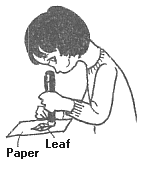
Internet Version [Naruhodo no Mori] Vol.60
by Yumiko Mori

Vol.60 November 15th, 2001
Penscope
Microscopic world
Home science experiments for mothers of elementary school children
Satoshi: "What are these?"
Mom: "They are pollens.
If you touch a flower, pollens may stick to your finger."
Satoshi: "Pollens have round shapes.
Oh, look!
I saw a insect."
Mom: "What?
Let me see."
Satoshi is looking through a penscope.
Now Mom wants to look at the insect Satoshi has found.
Mom: "Yes, I can see the insect.
It is so small.
We wouldn't see it by the naked eyes."
Satoshi: "What do you want to look the next time?"
Mom: "How about a eggshell?"
Satoshi: "I can't see anything on the shell.
It is just white."
Mom: "Look!
You should be able to see holes. "
Satoshi: "Yes, I can see holes.
Tiny, tiny holes!"
Mom: "I remember a book by Jean Henri Fabre described about eggshell holes.
He was right."
Satoshi: "Why does a eggshell have holes?"
Mom: "Apparently eggs need to breath too.
Air can go through these holes."
Satoshi: "I want to look other things through this penscope."
Mom: "How about this?"
Mom has brought fax prints.
Satoshi: "Look!
Fonts are jagged."
Mom: "Isn't that interesting?
These jagged shapes come from digital signals on Fax machine.
Each font is made of many tiny blocks."
Satoshi: "Are there any other things we can see?
Mom, how about your face?"
Mom: "No! Please don't do that!"
Materials

- A penscope (a microscope which look like a pen)
- 30x magnification, Some types have capability to be used as telescopes as well.
You may be able to find penscopes in museum shops.
approximately 500-1500 yen.

-
How to use a penscope
- Place what you want to observe under the penscope and illuminate the area with light.
The observed image is reversed in up-down and right-left directions.
So, if you want to move the object while you observe through the penscope, you should move toward the opposite direction.
Depending on what you want to observe, placing a white-colored or black-colored paper as the background may help.
Interesting objects to observe
- Insects
- We have found insects in our rice bin.
They were weevils.
Several days after we cleaned our rice bin, we found some dusts.
We thought they were rice debris, but it turned out to be insect eggs and worms, when we observed under the penscope.
- When we were observing dog hairs, we found something moving among dog hair.
It turned out they were small insects.
- When we were observing leaves from daikon radish plants, we found something moving.
They were insects whose color was very similar to the leaves.

- Plants
- Place flower pollens on a white paper and observe under the penscope.
Try any flowers such as cut flowers, flowers on your garden, or wild flowers.
- Also, take a walk with the penscope.
Observe leaves.
Check the front and the back.
Leaves have various microscopic surfaces.
Some leaves have hairs. Some leaves have sharp edges.
- Cut stems with a cutter.
Observe the cross sections under the penscope.
You may have to adjust the focus.
- Observe various parts of vegetables and fruits that you have in your home.

- Body
- Hair and hair roots.
Compare thickness among different hairs.
You may also want to observe gray hair.
- Observe your skin.
Compare your skin with others.
If interested, you may want to observe tongue or earwax.

* Eggshell holes are so small that even under the microscope the holes look like needle holes.
* Depending on Fax machines, fonts don't always look like jagged.
You may want to observe color-printed newspaper.
You should be able to see red, blue, and yellow dots.
* Try sugar or salt crystals.
Also flour particles.
* To observe molds, you need a more powerful microscope.
Microscopic world
When I looked through the penscope, I felt I was a scientist for the moment.
Since I dislike insects, I was very surprised when we have found very small insects under the penscope.
From now on, the world looks quite differently to me.
In this world, it is often difficult to see real shapes.
Probably studying real shapes of various things is the study area of science.
| Author | Yumiko Mori (Zushi, Kanagawa, Japan) |
|---|
| Illustration | Mitsue Ogata |
|---|
| Translator | Akira Ishihara |
|---|
| HTML format | Muneo Kume |
|---|
This is the last issue of "Naruhodo no Mori".
Thank you for your support and interest.
There must be many other science experiments you can try at your home.
If you find such experiments, please write your own version.
I look forward to hearing from you. |
Copyright © 2001 Yumiko Mori











